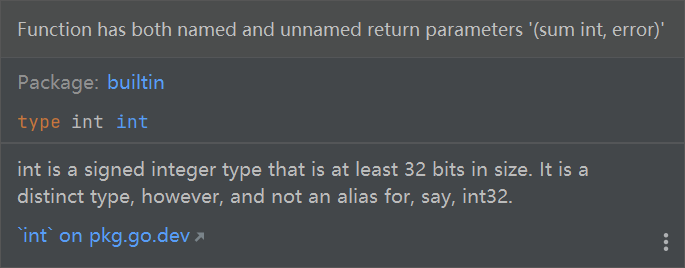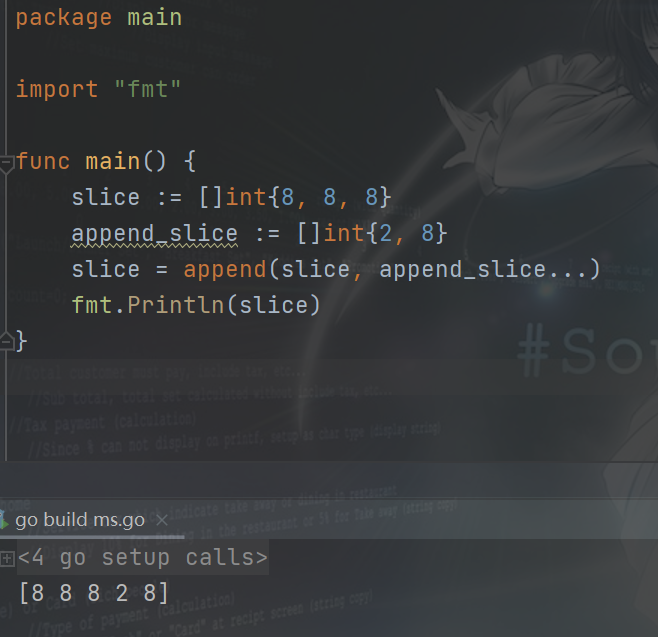Go语言学习查缺补漏ing Day2
一、函数返回参数命名的一个注意事项
请大家观察下面这个函数有什么问题吗?
func fun(x, y int) (s int, error) {
return x * y, nil
}
虽然这个错误,在集成开发环境Goland中会有提示,但是其他的开发工具,比如VS Code就不知道会不会提示了。

我们可以看到这个提示:函数有命名的返回参数,也有没有命名的返回参数。
这就说明函数有多个返回值参数时,如果你给一个参数命了名,那么其他参数也必须命名。而且如果给参数命名,那么必须给参数加上括号,无论参数个数是一个还是多个。这里给第一个参数命名为s,而没有给第二个参数命名,所以有错误。
二、new()和make()有什么不同?
在Go SDK中,对new的描述是这样的:
// The new built-in function allocates memory. The first argument is a type,
// not a value, and the value returned is a pointer to a newly
// allocated zero value of that type.
func new(Type) *Type
它是一个用于分配内存的内置函数,只有一个参数。如果使用这个函数,那么就会返回一个指向一块新开辟内存的指针,这块内存是第一个参数表示的类型的零值。
我们再来看一看make:
// The make built-in function allocates and initializes an object of type
// slice, map, or chan (only). Like new, the first argument is a type, not a
// value. Unlike new, make's return type is the same as the type of its
// argument, not a pointer to it. The specification of the result depends on
// the type:
// Slice: The size specifies the length. The capacity of the slice is
// equal to its length. A second integer argument may be provided to
// specify a different capacity; it must be no smaller than the
// length. For example, make([]int, 0, 10) allocates an underlying array
// of size 10 and returns a slice of length 0 and capacity 10 that is
// backed by this underlying array.
// Map: An empty map is allocated with enough space to hold the
// specified number of elements. The size may be omitted, in which case
// a small starting size is allocated.
// Channel: The channel's buffer is initialized with the specified
// buffer capacity. If zero, or the size is omitted, the channel is
// unbuffered.
func make(t Type, size ...IntegerType) Type
我们可以了解,make也是分配内存的,但是只能给slice, map 或者 chan分配内存。而且这个make也不返回指针,而是返回你第一个参数代表的类型的值。
经过上面的介绍,我们再来看一看这段代码能否通过编译。
import "fmt"
func main() {
l := new([]int)
l = append(l, 0)
fmt.Println(l)
}
显然是不能的,下面是报错信息:

我们前面讲了,new函数new出来的是指针,而指针是不能进行append操作的。所以我们建立slice, map 或者 chan最好使用make函数,而不要使用new函数。
三、切片追加切片问题
如果有两个切片,如何使用append把它们拼凑在一个切片里面呢?
这样行不行?
package main
import "fmt"
func main() {
slice := []int{8, 8, 8}
append_slice := []int{2, 8}
slice = append(slice, append_slice)
fmt.Println(slice)
}
看一看Goland怎么提示的吧。

好像是不行吧。
这时我们就要使用...这种语法糖。
它有多个功能,其中的一个功能就是可以把切片打散进行传递。还有就是在定义函数时使用,可以接收任意个参数。
下面是运行结果:

四、简短模式声明变量的限制
我们来看一看下面这一段代码,你觉得有没有什么问题?
package main
import "fmt"
var(
two = 200
)
one := 100
func main() {
fmt.Println(one,two)
}
是有问题的。
就得来谈一谈变量的简短模式声明有哪些限制:
- 必须使用显示初始化,也就是手工给予初值。
- 不能指定数据类型,编译器会根据你指定的初值自动推理变量的类型。
- 只能在函数内部使用简短模式来声明变量。
我们这里出现错误的原因就是触发了上述第三点限制:未在函数内部使用简短模式来声明变量。






















 505
505











 被折叠的 条评论
为什么被折叠?
被折叠的 条评论
为什么被折叠?










